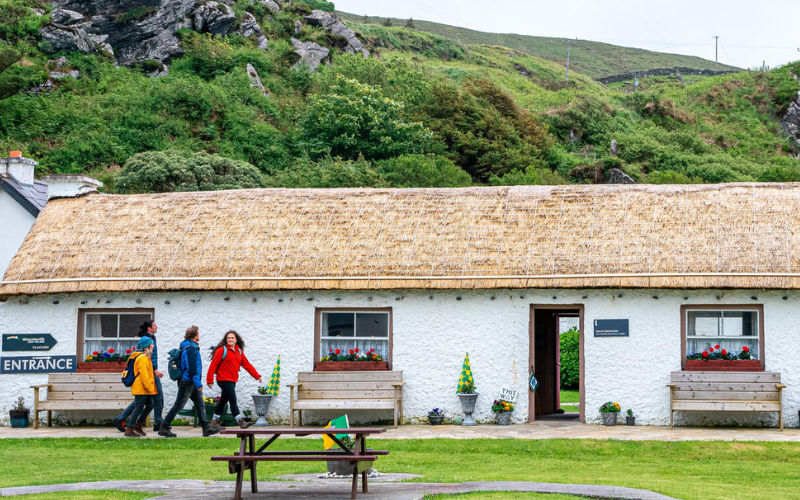“Few will have the greatness to bend history itself, but each of us can work to change a small portion of events. It is from numberless diverse acts of courage and belief that human history is shaped. Each time a man stands up for an ideal, or acts to improve the lot of others, or strikes out against injustice, he sends forth a tiny ripple of hope, and crossing each other from a million different centers of energy and daring those ripples build a current which can sweep down the mightiest walls of oppression and resistance.” ~ Robert F. Kennedy
In April 2015, when the Northern Ireland Assembly voted – again – against same-sex marriage, I was disappointed, but I was not without hope that change is coming. If a month later, the Irish Republic could become the first country to legalize same-sex marriage by popular, national vote, then surely the tide must turn in the North? What happened in Ireland in May 2015 is momentous, a seminal moment for a tiny country of less than 5 million people, a place where homosexuality was still a crime just 22 years ago, where divorce did not become legal until 1997, and where a woman still must travel to another country to have a legal abortion. Ireland acquiesced, acknowledging to the world that the sky is not falling; rather, the walls are coming down, the way Heaney reminds us in “The Cure at Troy”:
“But then, once in a lifetime
The longed-for tidal wave
Of justice can rise up
And hope and history rhyme.”
Lest we lose hope, the walls have come down in Northern Ireland in places we would never have expected. The Irish referendum on marriage equality coincided with the 17th anniversary of the Good Friday Agreement referendum in Northern Ireland. In 1998, with 71.12% of the people of Northern Ireland voted in favor of the accord. Would we ever have predicted such an outcome in 1969 when the walls of the “Peace Line,” over thirteen miles of them, started going up, keeping apart Belfast’s two divided communities. While these walls were erected only as a temporary measure, many have been standing for over four decades. That’s the thing about a wall – once it goes up, it seems to take a very long time to come down. It becomes a part of our external and internal geography, at once keeping us apart and a part. But they are coming down, in part due to negotiations that did not make the front pages. Since 2012, six of the walls have been removed, and more are slated to come down, but it will take time, as even an American President acknowledged when he visited Belfast, invoking Dr. King’s assertion about finiteness of disappointment but the infinite nature of hope:
“There are walls that still stand, there are still many miles to go . . . you have to remind us of hope again and again and again. Despite resistance, despite setbacks, despite hardship, despite tragedy, you have to remind us of the future again and again and again.”
Just last week, Belfast City Council backed same-sex marriage with 38 – 13 Councillors voting in favor of the motion proposed by Alliance party’s Emmet McDonough Brown. And on Saturday, June 13th, the March for Civil Marriage Equality in Belfast will allow the people to publicly show that they know how to do the right thing, as they have done before – to make a ripple.
I remember when once upon a time, before Home Economics was standard fare on the Northern Ireland curriculum, there was Domestic Science. Other than Physical Education, which I skillfully avoided with a note from my mother when I “had cramps,” it was my least favorite subject in school. It involved the planning of meals, cooking, baking, and, for a brief period, knitting. There was even some sewing, during which I learned how to finish the edges of something, presumably a blanket, with blanket stitch. I vaguely recall stitching the six letters of my name on an apron and wishing I had been christened, simply, “Eve.”
There were no boys in Domestic Science, nor were there any girls in Woodwork, Metalwork, or the exotic-sounding Technical Studies. Unbeknownst to me, however, there were some people who saw the fundamental unfairness of this situation. Apparently they had some clout too, because along came The Sex Discrimination (Northern Ireland) Order of 1976 which made unlawful the inequality of access for boys and girls to all areas of the curriculum. Landmark legislation, it enabled boys and girls in the same classroom, to partake of Craft, Design, and Technology, although it would be another 14 years before a National Curriculum would be implemented. For me, the “craft” component of both Domestic Science and CDT remained elusive. To be honest, two thirds of the latter course would have been beyond me unless the “craft” entailed extra-curricular knitting, which my mother would have done for me, bailing me out as she had done in Domestic Science when I was required to purple slippers.
In a classic case of putting the cart before the horse, my country was investigating ways in which to make Domestic Science and Technical Studies curricula more gender-neutral while at the same time segregating its children. Catholics and Protestants were educated in separate schools in often bitterly divided communities, until finally, a small group of Belfast parents dared to change the course of history, to force the issue, to confront aloud what happens to the heart of a country and the identity of its children when they are educated in segregated schools. Ordinary Catholics and Protestants, we already knew what happened. It was time for change, to demand an answer to questions such as this, asked in 1957 by Nobel Peace Prize recipient, Lester Bowles Pearson, “How can there be peace without people understanding each other, and how can this be if they don’t know each other?”
There is no better place to learn about one another, to learn about humanity, than in the safety of a classroom. In 1981, Lagan College became the first integrated secondary school in Northern Ireland to offer such a space for boys and girls, Catholics and Protestants. On the first day of school, under armed guard, Lagan College opened its doors to 28 children. It is different today.
According to the school’s website, as of January 2014, there are 1262 pupils on its Lisnabreeny campus with more than 80 teachers. It is now a 21st century school with a curriculum that includes Home Economics, the central focus of which is “the consideration of the home and family in relation to the development of the individual and society and is designed to enable students to acquire the knowledge and skills to improve the quality of life for themselves and others. During the three years, they will address the areas of Diet and Health, Family Life and Choice and Management of Resources, using a variety of teaching and learning techniques.” That sounds infinitely more important and relevant than the Domestic Science of my youth.
Still, the one thing I retained from my spell in that classroom was the textbook, the “Hamlyn all Colour Cookbook.” A dust collector these days, it is of little practical use with its metric measurements. I cannot bear to part with it. I remember my mother and me, poring over the pictures in my cookbook when it was brand new, ma delighted to find so many cakes and sweets she already knew how to make, without as much as a precise measurement, let alone a “method” like the one we had to write out in our Domestic Science notebook. Like her mother before her, she did not measure, but she somehow timed everything so that by the end of the day, before daddy came home from work, the square biscuit tins left over from Christmas and assorted Tupperware containers were lined with greaseproof paper and filled to their brims with caramel fingers, melting moments, fudge cakes, shortbread, and butterfly buns. For Sunday dessert, we had a choice of apple tart, Pavlova, Trifle, a Victoria Sponge, or a Swiss Roll. Honestly, I am surprised we still have teeth.
While she had actually copied down many of these recipes, which I stuck inside a book for future reference, ma never took much notice of them. No doubt, my
Domestic Science teacher would have dismissed my mother’s fruit cake “method” as highly unsatisfactory – unconventional - without the obligatory list of ingredients, precise measurements, and numbered directions copied into notebooks by girls – only girls – in the classrooms of segregated schools.
Things are different today, and better, but only for some people. If it’s not better for everyone, then what does that say about Northern Ireland as a 21st century country? According to Patrick Corrigan Director of Northern Ireland’s Amnesty International program, the country is “now the last bastion of discrimination against gay people in these islands.” This is why on June 13, I will be in Belfast, to march for equality, for love, at the demonstration organized by the Rainbow Project, Amnesty International, and the Irish Congress of Trade Unions – to send forth a tiny ripple of hope.
In April 2015, when the Northern Ireland Assembly voted – again – against same-sex marriage, I was disappointed, but I was not without hope that change is coming. If a month later, the Irish Republic could become the first country to legalize same-sex marriage by popular, national vote, then surely the tide must turn in the North? What happened in Ireland in May 2015 is momentous, a seminal moment for a tiny country of less than 5 million people, a place where homosexuality was still a crime just 22 years ago, where divorce did not become legal until 1997, and where a woman still must travel to another country to have a legal abortion. Ireland acquiesced, acknowledging to the world that the sky is not falling; rather, the walls are coming down, the way Heaney reminds us in “The Cure at Troy”:
“But then, once in a lifetime
The longed-for tidal wave
Of justice can rise up
And hope and history rhyme.”
Lest we lose hope, the walls have come down in Northern Ireland in places we would never have expected. The Irish referendum on marriage equality coincided with the 17th anniversary of the Good Friday Agreement referendum in Northern Ireland. In 1998, with 71.12% of the people of Northern Ireland voted in favor of the accord. Would we ever have predicted such an outcome in 1969 when the walls of the “Peace Line,” over thirteen miles of them, started going up, keeping apart Belfast’s two divided communities. While these walls were erected only as a temporary measure, many have been standing for over four decades. That’s the thing about a wall – once it goes up, it seems to take a very long time to come down. It becomes a part of our external and internal geography, at once keeping us apart and a part. But they are coming down, in part due to negotiations that did not make the front pages. Since 2012, six of the walls have been removed, and more are slated to come down, but it will take time, as even an American President acknowledged when he visited Belfast, invoking Dr. King’s assertion about finiteness of disappointment but the infinite nature of hope:
“There are walls that still stand, there are still many miles to go . . . you have to remind us of hope again and again and again. Despite resistance, despite setbacks, despite hardship, despite tragedy, you have to remind us of the future again and again and again.”
Just last week, Belfast City Council backed same-sex marriage with 38 – 13 Councillors voting in favor of the motion proposed by Alliance party’s Emmet McDonough Brown. And on Saturday, June 13th, the March for Civil Marriage Equality in Belfast will allow the people to publicly show that they know how to do the right thing, as they have done before – to make a ripple.
I remember when once upon a time, before Home Economics was standard fare on the Northern Ireland curriculum, there was Domestic Science. Other than Physical Education, which I skillfully avoided with a note from my mother when I “had cramps,” it was my least favorite subject in school. It involved the planning of meals, cooking, baking, and, for a brief period, knitting. There was even some sewing, during which I learned how to finish the edges of something, presumably a blanket, with blanket stitch. I vaguely recall stitching the six letters of my name on an apron and wishing I had been christened, simply, “Eve.”
There were no boys in Domestic Science, nor were there any girls in Woodwork, Metalwork, or the exotic-sounding Technical Studies. Unbeknownst to me, however, there were some people who saw the fundamental unfairness of this situation. Apparently they had some clout too, because along came The Sex Discrimination (Northern Ireland) Order of 1976 which made unlawful the inequality of access for boys and girls to all areas of the curriculum. Landmark legislation, it enabled boys and girls in the same classroom, to partake of Craft, Design, and Technology, although it would be another 14 years before a National Curriculum would be implemented. For me, the “craft” component of both Domestic Science and CDT remained elusive. To be honest, two thirds of the latter course would have been beyond me unless the “craft” entailed extra-curricular knitting, which my mother would have done for me, bailing me out as she had done in Domestic Science when I was required to purple slippers.
In a classic case of putting the cart before the horse, my country was investigating ways in which to make Domestic Science and Technical Studies curricula more gender-neutral while at the same time segregating its children. Catholics and Protestants were educated in separate schools in often bitterly divided communities, until finally, a small group of Belfast parents dared to change the course of history, to force the issue, to confront aloud what happens to the heart of a country and the identity of its children when they are educated in segregated schools. Ordinary Catholics and Protestants, we already knew what happened. It was time for change, to demand an answer to questions such as this, asked in 1957 by Nobel Peace Prize recipient, Lester Bowles Pearson, “How can there be peace without people understanding each other, and how can this be if they don’t know each other?”
There is no better place to learn about one another, to learn about humanity, than in the safety of a classroom. In 1981, Lagan College became the first integrated secondary school in Northern Ireland to offer such a space for boys and girls, Catholics and Protestants. On the first day of school, under armed guard, Lagan College opened its doors to 28 children. It is different today.
According to the school’s website, as of January 2014, there are 1262 pupils on its Lisnabreeny campus with more than 80 teachers. It is now a 21st century school with a curriculum that includes Home Economics, the central focus of which is “the consideration of the home and family in relation to the development of the individual and society and is designed to enable students to acquire the knowledge and skills to improve the quality of life for themselves and others. During the three years, they will address the areas of Diet and Health, Family Life and Choice and Management of Resources, using a variety of teaching and learning techniques.” That sounds infinitely more important and relevant than the Domestic Science of my youth.
Still, the one thing I retained from my spell in that classroom was the textbook, the “Hamlyn all Colour Cookbook.” A dust collector these days, it is of little practical use with its metric measurements. I cannot bear to part with it. I remember my mother and me, poring over the pictures in my cookbook when it was brand new, ma delighted to find so many cakes and sweets she already knew how to make, without as much as a precise measurement, let alone a “method” like the one we had to write out in our Domestic Science notebook. Like her mother before her, she did not measure, but she somehow timed everything so that by the end of the day, before daddy came home from work, the square biscuit tins left over from Christmas and assorted Tupperware containers were lined with greaseproof paper and filled to their brims with caramel fingers, melting moments, fudge cakes, shortbread, and butterfly buns. For Sunday dessert, we had a choice of apple tart, Pavlova, Trifle, a Victoria Sponge, or a Swiss Roll. Honestly, I am surprised we still have teeth.
While she had actually copied down many of these recipes, which I stuck inside a book for future reference, ma never took much notice of them. No doubt, my
Domestic Science teacher would have dismissed my mother’s fruit cake “method” as highly unsatisfactory – unconventional - without the obligatory list of ingredients, precise measurements, and numbered directions copied into notebooks by girls – only girls – in the classrooms of segregated schools.
Things are different today, and better, but only for some people. If it’s not better for everyone, then what does that say about Northern Ireland as a 21st century country? According to Patrick Corrigan Director of Northern Ireland’s Amnesty International program, the country is “now the last bastion of discrimination against gay people in these islands.” This is why on June 13, I will be in Belfast, to march for equality, for love, at the demonstration organized by the Rainbow Project, Amnesty International, and the Irish Congress of Trade Unions – to send forth a tiny ripple of hope.




Comments